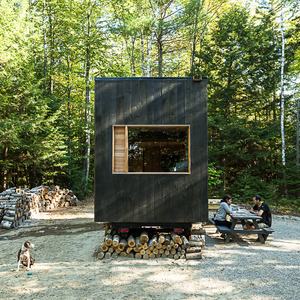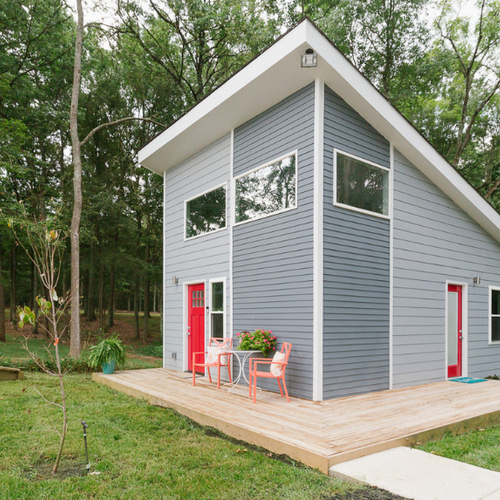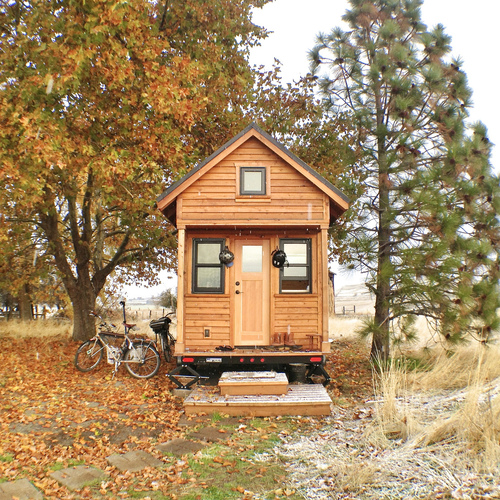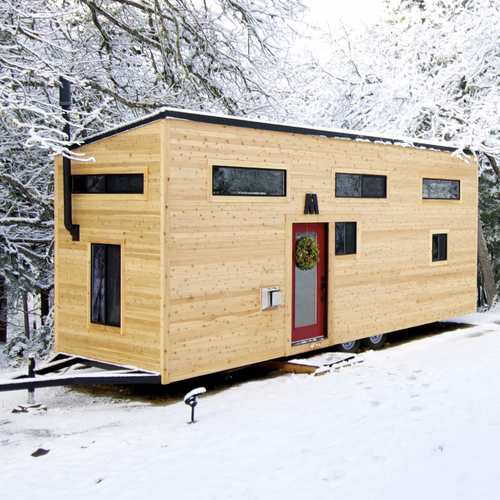
Image Credit: Gabrielle Morrison
The tiny house movement got an early Christmas present this year: a place in the country’s dominant model building code.
Members of the International Code Council, the group that publishes the International Residential Code, have approved a proposed standard written specifically for houses smaller than 400 square feet. It’s the first time these very small dwellings have been covered by the model building code, and a major boost for the loosely knit coalition of builders and homeowners advocating a lifestyle based on downsizing and simplifying.
The victory comes in the form of an appendix to the next version of the IRC, which could be adopted by local jurisdictions in 2018. The standard covers details such as minimum loft dimensions, stairways, landing platforms, loft guards, and emergency openings — areas where tiny houses have been unable to meet code provisions for standard-sized homes.
Andrew Morrison, a builder and tiny house advocate who led the effort to get tiny houses covered in the code, made the announcement at his website, TinyHouseBuild.com, on Dec. 6.
“As you can likely imagine, I am more than completely, utterly, and totally excited to share the news that the tiny house appendix passed,” Morrison wrote. “This is huge news for the tiny house community. It means that we will be able to work towards adoption across the U.S. now. That’s another challenge that will take a lot of effort, but we can do it!”
Morrison, who lives in a 317-square-foot house on wheels in Oregon with his wife Gabriella and their daughter, said more than 162,000 votes were cast in the electronic balloting on the dozens of code changes up for approval. (Gabriella Morrison wrote about their house in a blog at GBA last year.)
Vote totals weren’t posted at the ICC website, and the ICC did not return a telephone message seeking comment. The results must still certified.
In a blog posted at Fine Homebuilding in November, Morrison wrote the issue of code compliance was moving to the front burner as more people built or purchased tiny houses.
The houses have become increasingly popular, not only on the part of homeowners who want cheaper, smaller places to live, but also by communities looking for alternatives to low-income housing and new ways to beef up existing housing stock.
Where tiny houses go from here
Passage of the appendix is a major step toward encouraging more people to build tiny houses, Morrison said in a telephone interview.
“Exactly how it will play out I don’t know, but basically it provides a national code for tiny houses,” he said. “The biggest impact is going to be the number of people who have wanted to build something tiny but haven’t been able to do so legally. I think it’s going to open a big market for those people to step into the tiny house concept and build tiny houses all over the country — legally.”
One issue that isn’t quite settled is what many tiny houses are built on — a trailer. The new standard does not address that directly, leaving it up to individual homeowners to convince local building officials to permit a moveable house.
“That’s going to be our next move in the next code cycle,” Morrison said. “We’re going to put another appendix that addresses moveable tiny houses. That said, [the appendix] addresses basically all of the issues that people with moveable tiny houses have — ceiling heights, sleeping lofts, emergency rescue and escape — all those sorts of things. The only thing it doesn’t cover is the trailer itself.”
Applicants will be able to seek local approval through Section R104.11 of the IRC, which permits alternative designs and materials.
“They could go in with an engineered plan for their foundation, i.e. the trailer, and that would be their only hiccup or hurtle they would have to prove to the building department that was worthy of acceptance,” Morrison said.
Appendix must be adopted separately
Morrison and other advocates still have some lobbying to do. Jurisdictions adopting the 2018 IRC don’t automatically endorse the appendix covering tiny houses, Morrison said. That’s one of the quirks of the system.
“You can take them or you don’t have to,” he said of any appendices attached to new versions of the IRC. “Our goal is to get all of the jurisdictions that we can to adopt the appendix, and then after that, or maybe simultaneously to that, will be to write the moveable tiny houses proposal and get that moving through the next code cycle for the 2021 IRC.”
The IRC is updated every three years, but it takes years for new versions to filter their way into law. Although Morrison and others are looking ahead to the 2018 code, many states are still using versions of the IRC from 2012 and even 2009.
Weekly Newsletter
Get building science and energy efficiency advice, plus special offers, in your inbox.















6 Comments
One step, more to go
While this is a GREAT first step the hurdles facing prospective tiny house builders are still quite large. I am still looking for the right piece of property to build my small house. Once I factored in a reasonable commuting distance, communities with restrictive building codes (really, 1000ft2 minimum BRICK houses in one area!) and not wanting to live in a HOA (often also associated with the previous restriction) my options are quite limited. Still it is better wait years for just the right place if necessary.
Tiny House code
This is very encouraging in a country where the trend has been in the opposite direction of "Bigger is Better". It is very perplexing to me that so many Americans believe that it is necessary to have 2000 or 3000 sq. ft. of living space per person for "Happiness". This is especially disturbing when over half a million people are homeless & another 1.5 million are just one step away from being homeless. It makes me proud that this effort to legitimize the Tiny House movement has happened in my home state or Oregon. Thank you, Andrew & Gabriella Morrison!
How strict is it?
Are the requirements in the new model code consistent with the construction we see on the various tiny house TV programs on HGTV and DIY network? Most of those have:
- really steep, often moveable, stairs with no railings
- sleeping lofts you could barely sit up in with no separate egress
- negligible floor insulation, at best about R10 walls and roof.
Regarding trailer "foundations," my understanding is that one of the main reasons people have been putting tiny houses on trailers is that exempts them from building codes, which they would not pass. If that is the case, a tiny house building code would make people more likely to build on a fixed foundation.
Consequences
I don't think the size of tiny houses is really the issue. Many jurisdictions already allow micro-condos or secondary suites in backyard cottages, and codes adapt. The real problem with the "movement" is their conflation of small dwellings, whether stand alone or in multi-family building with those on trailers.
Some builders are definitely putting small houses on trailers to avoid building code concerns, but I bet just as many do so because the economic realities of building mitigate against very small houses.
When I break down the cost of building a house here, the fixed expenses, that is those which are largely independent of the dwelling size (like fees, power hook-up, septic, site work, etc), are a large portion of my budget. This means that building a moderately sized house is almost a cheap as building a smaller one.
The appeal of building on a trailer is to avoid these costs - or more accurately to offload them onto someone else. You can't just wander down a country lane, find a picturesque spot and settle down. You need to find somewhere that already has the necessary services. The picture accompanying this article illustrates this perfectly. It would be instructive to know how the occupants handle services in their spot nestled under that tree or how during their tenure there they are contributing taxes to the community that is supporting them.
Just how communities are supposed to deal with a large increase in trailer homes, or why they should be distinguished form their manufactured versions, are open questions I don't see the "movement" offering answers to.
Lack of insight
Who in world are these folks who sit in their castles passing ridiculous edicts with the supposition it will encourage the tiny home 'movement'. There is a reason folks build tiny homes, and one reason only, cost. Adding these building codes, however generous, will kill the industry. Good news for RV makers though.
Folks build tiny homes to skirt the onerous requirements of a fixed home.
This nonsense to bring them into the fold is nothing more than a fleecing. Guaranteed. You can be guaranteed local authorities will eagerly adopt these regs, with a price tag attached.
How about doing something positive, like downsizing the regs on small fixed homes? The real game ought to be getting economically challenged folks into a fixed home. You know, one attached to a foundation, with services.
Will get way better housing stock than a tent in the bush.
We are building a tiny house on wheels because we need the flexibility and the freedom...not to cheat our way out of responsibility. Our lifestyle will require us to move frequently, so the stress of changing houses each time is what we are trying to avoid. Also, because we live more simply and spend less on huge mortgages & utilities in a small space (heating, AC, electricity, etc) we have more money to spend on enriching our family life and our community.
We also seek to have a smaller impact on the environment. Smaller house = less waste in many ways. Plus, because they are smaller, tiny house owners can afford to purchase more green, energy efficient materials (which are often cost prohibitive for owners of larger homes) and go almost completely solar.
This side of the story is not typically considered by those who are not fond of the THOW concept. It is NOT because we want to ignore building codes, not pay taxes, or avoid all costs associated with traditional home ownership. People like us who choose tiny mobile life, but don't want to live in/raise children in a camper, are in the right to create dwellings that are both homely and transportable. We're fighting for that freedom, and the ability to be recognized as homeowners responsible to pay our taxes, build safe code-approved homes, and be solid contributing members of society.
I am so excited that THOWs and other tiny dwellings are being adopted into the same safety standards as traditional homes. It will make our homes safer, ease the minds of our neighbors, and help families in THOWS to protect their freedoms and continue living as active members of their communities without discrimination.
Log in or create an account to post a comment.
Sign up Log in